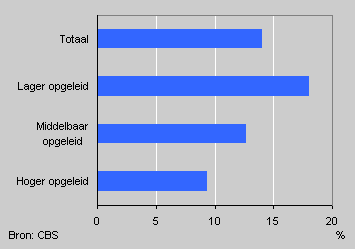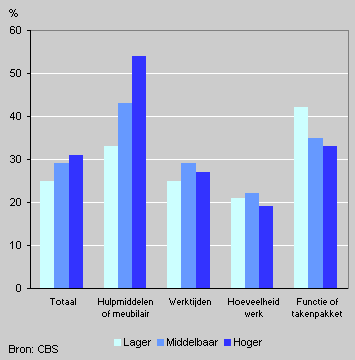Lower educated more often incapacitated

One in seven people aged 15-64 years in the Netherlands is incapacitated and not able to work. People with a lower level of education are twice as likely to be incapacitated as those with a higher education. Workplace adaptations are also less often carried out for people with a lower than for people with a higher education.
1.5 million incapacitated
In 2001, 14 percent of 15-64 years-olds were incapacitated. People with a lower level of education were twice as likely to be incapacitated as those with a higher education: 18 percent of people with lower educational levels had a handicap, compared with 9 percent of those with higher educational levels.
Percentage of incapacitated, 2001

Lower educated workers more often incapacitated
The higher rates of incapacitation among the lower educated group are mainly caused by the fact that this group comprises more older people . Older people are more likely to be incapacitated than young people. In addition, more lower educated people work in sectors of industry where relatively many occupational handicaps occur, such as agriculture and manufacturing.
Furniture and tasks often adjusted
To keep incapacitated people in the labour process as long as possible, employers can adapt furniture or equipment to accommodate handicapped workers or provide special aids. Tasks and responsibilities can also be changed to suit someone with a certain handicap. Such adaptations had been made for 28 percent of incapacitated people in work in the previous last twelve months.
Fewer adaptations for lower educated
Adaptations to equipment or tasks had been made for one quarter of lower educated incapacitated workers in the last twelve months, and for one third of higher educated workers. Adaptations are therefore less likely to be made for people with lower education with a work handicap.
Incapacitated workers by adaptations at work, 2001

Different adaptations for higher educated
Fifty-four percent of higher educated people with a handicap had had their furniture or equipment adapted or had received aids to do their work. For those with a lower educational level this was only 33 percent. For 33 percent of higher educated people, the job content had been adjusted; for lower educated this was the case for 42 percent.
Astrid Smits